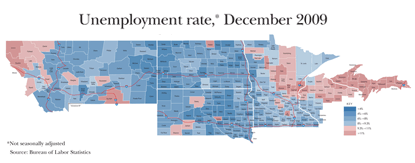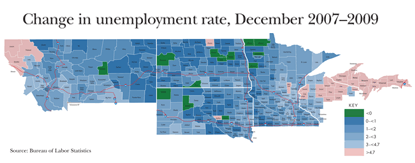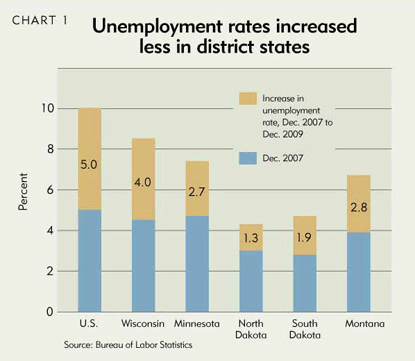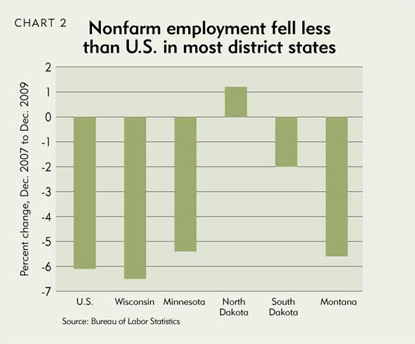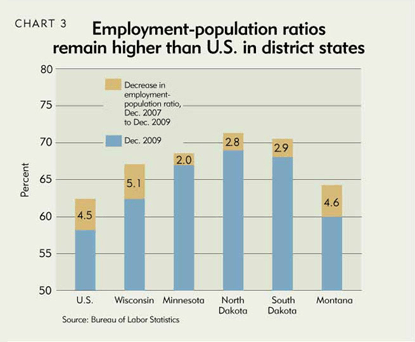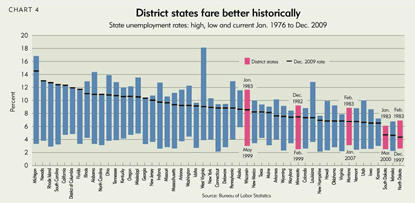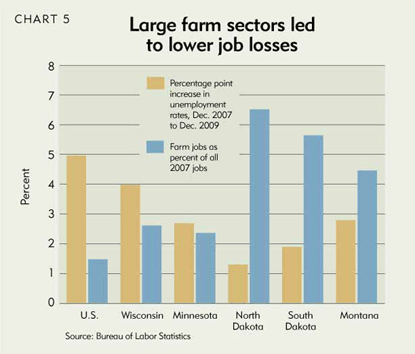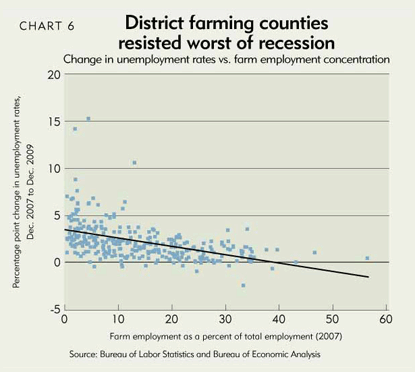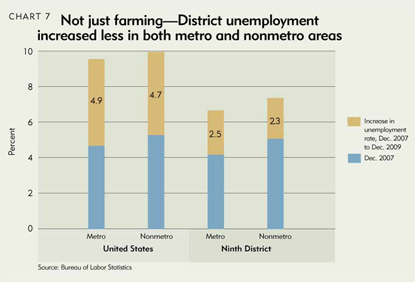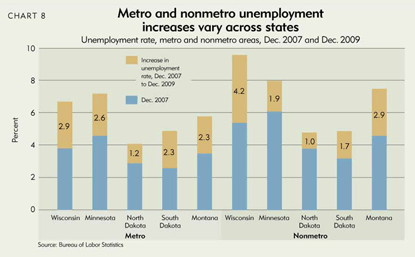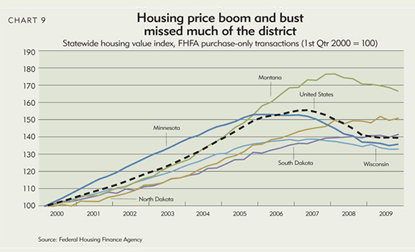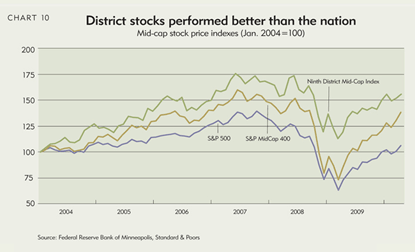
Here’s a recession version of the Myers-Briggs personality test: Having lived through one of the worst economic periods in America over the past half-century, are you now economically half-full or half-empty?
That probably depends on with whom or what you compare yourself, whether it be the neighbors next door, people in the state nearby or the people and places nationwide profiled in myriad news articles. Your own circumstances—what life was like a few years ago—likely play a role in your outlook as well.
But by most of these parameters, Ninth District states should be a generally cheery group. Though they have definitely felt the recession’s sting, district states and regions are nonetheless the likely envy of peers nationwide because they have generally suffered less economically.
That “suffering lite” notion might not exactly replace any state mottos (“At least we’re not you!”) but it’s nonetheless a palpable perception in much of the Ninth District. The data say so, in fact. Compared with the country as a whole, unemployment levels were low in district states leading into the recession, and a lower percentage of workers have subsequently lost their jobs. It’s hard to pin down exactly why this happened, but some of this “less bad” performance appears to stem from the stabilizing effect of a relatively good farm economy during the recession, and the comparatively moderate pace of housing and general economic growth leading into the recession.
Economists credit an abundance of developable land for helping to restrain the rise in housing prices, while many sources attribute the region’s resilience to a conservative culture in the Midwest and Great Plains that forgoes some economic gung-ho in exchange for less economic oh-no.
Supporting what the data say, many people across the district—though not all, of course—acknowledge that their city, region or state is faring better than their peers nationwide. An over-the-shoulder optimism is becoming more noticeable.
“If we were in Florida, I would say, ‘Oh my God, we’re [still] in a recession,’” said Bob McCoy, president of the Eau Claire (Wis.) Chamber of Commerce. But in Eau Claire, “we don’t feel that because we don’t have those big swings.”
Go west, and you’ll bump into Steve Scheel, who knows a little something about recessions. He’s the CEO of Scheels, a 23-store sporting goods chain headquartered in Fargo, N.D., with stores in eight states, running from Wisconsin and Nebraska west to Nevada, and including the two largest all-sporting-goods stores in the world. Scheel, the great-grandson of founder Frederick Scheel, has been in the business for 39 years, and despite some missteps recently—like opening a huge new store in recession-shocked Nevada—“we are a stronger force in retail today than we were three years ago.”
At the western edge of the Ninth District, things are not exactly exuberant in Helena, Mont., according to Mike Mundt, senior vice president of American Federal Savings Bank. Asked about the regional mood, Mundt said it was merely “slightly upbeat,” but he acknowledged that it ranked ahead of many communities. “Most of us recognize that Montana and other mountain states have fared well in comparison to other states nationally. ... I hear people say often, ‘We’re not as bad off as most.’”
First, the bad news
It must be stressed that this is a positive, “if life gives you lemons” spin on a crushing economic event nationwide.
The Great Recession should no longer need an introduction. It has flipped people, businesses and entire regions on their heads and shaken them for loose change. Led—and intensified—by a collapse in financial markets, the longest recession in generations has left deep economic, emotional and even policy scars. Though district states may have been less brutalized compared with places like California, Florida and Nevada, all have watched unemployment rates rise, businesses go under, foreclosure signs go up and families struggle. (For more information on the comparative depth of this recession, see the “Recession in Perspective” feature.)
Though recessions are often viewed as communal tragedies, they never evenly distribute economic pain and dislocation. That some people and regions relatively close by have experienced less pain is likely cold solace to those directly and harshly affected. Today, many in the Ninth District still don’t view their local economy or individual prospects very positively.
Mary Trembley, an investment executive with Raymond James in Anoka, Minn., said by e-mail that her profession allows her to “see how [people] are feeling about the economy and the markets. … General consent seems to be that we are all still struggling.” Trembley, also a board member of the Anoka Area Chamber of Commerce, added: “Businesses are still experiencing slow sales. I belong to several business networking groups, and they continue to rise in member numbers because people are still really struggling. They are looking for any alternative to assist them with their business.”
The St. Cloud, Minn., region has been publishing a quarterly survey of business conditions since 1998. The most striking part of this recession for St. Cloud has been its breadth and depth; across the board, economic indicators and industrial sectors were much weaker than in the 2001 recession, according to Richard MacDonald, an assistant professor of economics at St. Cloud State University (SCSU), which publishes the survey. “These survey readings suggest a much darker mood of business leaders” regarding the current recession, said MacDonald.
Entire regions in the Ninth District have been trampled by the recession, including the very eastern and western edges (see maps below). Michigan is Exhibit A. The state saw its unemployment rate skyrocket from 8.3 percent in 2008 to 13.6 percent last year—both well above the national average. Statistically speaking, nowhere in the Upper Peninsula (the only portion of Michigan that lies within the Ninth District) do conditions look positive. Baraga and Mackinac counties bear unemployment rates topping 27 percent.
On the good side—if you can call it that—its largest county (Marquette) has the lowest unemployment rate in the U.P., and one of the state’s lowest. Still, its 11.2 percent rate at the end of last year was higher than the national average and the vast majority of county averages across the Ninth District.
But scratch the surface a little, and you’ll start to hear a different story from officials in and around Marquette than the one told by government data. For example, you won’t find city of Marquette Mayor John Kivela crying over his luncheon pasties.
“I would say we’re pretty optimistic. We have not been hit very hard” by the recession, he said. Housing prices in the city actually rose last year—only 0.4 percent, but that’s better than most housing markets. And at a time when commercial real estate markets are reeling, “we’ve got new construction downtown.”
In other words, Marquette just doesn’t fit the recession-woe profile that statistics might suggest. “Marquette is kind of an anomaly, not only in the U.P., but the entire state of Michigan,” said Kivela.
Tom Nemacheck, head of the Upper Peninsula Travel & Recreation Association, took that notion a step further, at least from a tourism standpoint. “We’re pretty optimistic,” he said. “Except for a couple of pockets, I don’t think the Upper Peninsula has been as hard hit as lower Michigan.”
There were a lot of doomsday predictions for tourism, Nemacheck said, but they never really materialized in the U.P. Lodging revenue was up about 1 percent to 2 percent last year, whereas other regions nationwide saw tourism drop by as much as 15 percent to 20 percent. Though the U.P. is often perceived as the laggard, Nemacheck said, “in this case we kept our head above water, and it feels like the other places took a bigger hit.”
You should see the other guy
As it turns out, that “could’ve been worse” theme runs through most of the Ninth District—not only from sources, but from reams of data. To get a better idea of comparable performance from 2007 through 2009, the fedgazette analyzed employment patterns across various geographic jurisdictions (states, counties, metro versus rural) as well as other categorical frameworks, such as industry sectors and against past recessions.
In general, Ninth District states fared relatively well against states nationwide in terms of total job losses and unemployment rates. Though unemployment rates have grown considerably in the past two years, they grew less than the national average in district states over the past two years (see Chart 1). Just as important, unemployment rates in the district were lower to begin with. In December 2009, North Dakota and South Dakota had the two lowest unemployment rates in the nation, with both still under 5 percent. Larger district states—Minnesota and Wisconsin—didn’t perform as well, yet they did outperform the nation.
Changes in the number of people with a job (so-called total nonfarm employment) were less favorable in some district states, particularly outside the Dakotas (see Chart 2). And although the employment-population ratio (the proportion of working-age people with jobs) in all district states declined during the recession, it was still considerably higher last year than the national average (see Chart 3).
Big deal? Maybe not before the recession, when such arcane comparisons were the purview of economists and policy wonks. But it’s a big deal now, because the recession has focused society’s attention back on earned income, the lifeblood of mortgage and car payments, savings and discretionary spending upon which so many businesses rely. And in district states, the ratio of people still earning a paycheck is considerably higher than in the nation as a whole.
In a nutshell, unemployment rates and employment-population ratios both indicate that, at least in terms of employment, district economies entered the recession in better shape, lost a lower proportion of jobs and had a higher percentage of folks still employed. A triple winner—or at least a triple nonloser—which is pretty good under the circumstances.
Superiority complex
An economics history buff might tell you that some of this performance could have been predicted based on past experience. Since 1976, and covering five separate recessions (including 1980 and 1981–82, which many lump together), unemployment rates in district states generally have been less volatile—the spread between their highest and lowest unemployment rates during this period has been narrower than in most states (see Chart 4).
Wisconsin and Michigan are the exceptions. Though only portions of each state are in the district, the U.P. and northwestern Wisconsin represent an eastern bookend of counties with the highest unemployment rates and the largest increase in joblessness in the entire district (see maps). Wisconsin’s current rates, however, are well below their post-1976 peak.
On the other end of the spectrum, the Dakotas and Montana have had much less volatility in their unemployment rates since the mid-1970s. Their current rates are running well below peak levels and are among the lowest in the country right now.
There are likely many reasons for the district’s general lack of volatility in joblessness over the past three and a half decades, including the region’s relatively well-educated workforce. Other factors are unique and episodic—like the current oil boom in North Dakota, which has made the state an anomaly even within the district (see sidebar). Perhaps the Midwest work ethic even plays a role—district states tend to have a higher percentage of multiple job holders.
Farming also appears to have played an important role in cushioning the blow of the recession in western states and greater Minnesota (see Chart 5). That was particularly the case early in the recession when commodity prices skyrocketed in 2008 and farm income soared. Commodity prices and farm income have since declined—dairy and hog farmers, in particular, have seen tough times. But in general, agriculture has been stable enough to help prop up local and regional economies, especially in counties where farming plays a proportionately larger role (see Chart 6).
Another factor appears to be the lack of any disproportionate blight from an industry and geographic standpoint. For example, industry sectors in the district mostly outperformed their peers nationwide. As a useful cross-check, fedgazette analysis also found that metro and nonmetro areas in the district outperformed those across the nation (see Chart 7)—mostly because metro/nonmetro performance among the district states was fairly uniform (see Chart 8). As they say, all for one and one for all, at least for the Ninth District.
There are also historical considerations: In fact, this recession looks much like previous recessions, if on steroids. For example, the job loss pattern in this recession is fairly typical of past recessions: Minnesota and Wisconsin are big, diverse economies that tend to move with U.S. trends; total unemployment and its growth during this recession in these two states reflect that link.
At the other end, the Dakotas and Montana are smaller and historically have tended not to follow the U.S. economy as much because they are more heavily tied to fluctuations in farm and natural resource markets. As in the past, this recession has been more muted in the Dakotas.
Housing: No go boom
Another likely reason that the recession has not been as deep in the district is a comparatively smaller decline in its housing market. Make no mistake, the housing boom paid a visit to the Ninth District, but it didn’t move in and change the locks. And while the housing industry has experienced unrivaled decline in some areas—like the Twin Cities, which heavily influences statewide housing trends in Minnesota—the overall decline in the Ninth District pales in comparison to the devastation and ongoing tumult in states like Florida, Nevada, Arizona and California.
Some regions have suffered a housing double whammy from the collapse in construction and real estate, as well as the wood products industry that supplies housing materials. This is how the western edge of Montana got clobbered. From 2002 to 2007, Montana home price appreciation easily outstripped other district states and the national average (see Chart 9).
The city of Kalispell and its home county of Flathead in western Montana was the “epicenter of the recession in Montana,” according to a research article by Patrick Barkey of the Bureau of Business and Economic Research (BBER) at the University of Montana. Once the fastest-growing region of the state, and subsequently one of its hottest housing markets, the greater Kalispell region saw a collapse in housing and real estate accompanied by a “seemingly endless” series of bad news and reductions in the wood products industry across the northwestern corner of the state, according to Barkey.
Flathead County saw housing starts last year decline by 41 percent, and they are down 73 percent from their peak earlier in the decade, according to BBER research. The drop-off has hammered the local job market; by the end of 2009, Flathead County’s unemployment rate had reached 10.9 percent, up from just 5.3 percent two years earlier. In contrast, rates in Gallatin and Missoula counties—both of which have larger, more diversified economies—were 6.5 percent or lower, even though housing starts had fallen at a similar rate as in Flathead.
Sources elsewhere cited the inverse—a lack of a housing frenzy—as a central reason that many Ninth District regions were digging out of a smaller hole than most. For example, the Eau Claire area didn’t experience a big run-up in land and housing prices like other regions did—much to the chagrin of area residents at the time.
“We were discouraged when housing and land prices were really going up everywhere” except Eau Claire, said McCoy, from the local chamber. But that’s turned out to be a blessing in disguise. McCoy credited that lack of a boom for the region’s tentative optimism now. “We didn’t crash like everywhere else. … [Housing prices] went down a little, but they are coming back now.”
The unemployment rate in the Eau Claire region has risen by almost 90 percent, but that’s deceiving. Unemployment stood at just 3.4 percent in 2007, and its 6.1 percent rate in 2009 is significantly lower than the state’s average. “We haven’t seen the big job losses” from major employers in the region, McCoy said. “There have been no big dips. … We’re kind of just bumping along.”
He acknowledged that things aren’t perfect—retail sales have been up and down, and the banks are stable, “but they all [got] a few houses back” through foreclosure. The annual number of new homes went from about 100 to only about 35 last year. But the area also saw two new firms announce they were coming to town—a software company planning to add 30 to 50 people, and the other a computer support firm planning to hire three times that number. Local construction employment has been growing strongly in Eau Claire in early 2010, thanks to a new Luther Midelfort Mayo hospital and new Nestlé manufacturing plant.
Is it gone yet?
None of this should minimize or ignore the immense dislocation caused by the recession, or give the impression that the economy has regained its rose tint. It cannot be overstated that district states have a long way to go to get back to prerecession normal. Forecasters predict that it could take several years for unemployment rates to come down.
Asked this past spring by a St. Paul reporter whether the recession was over, Dan McElroy, commissioner of the Minnesota Department of Employment and Economic Development, replied, “Only to an economist.”
But signs of comparative health are hard to ignore. Among the nation’s 49 metro regions with at least 1 million people, the Twin Cities saw the smallest unemployment increase (2.8 percentage points) from January 2008 to January 2010, according to the U.S. Department of Labor. When it registered 7.7 percent in February, the Twin Cities became the only large metro to post a decrease (0.3 percent) over a year earlier.
More notable still, the Twin Cities would be considered a laggard among district metros. Bismarck and Fargo, N.D., along with Sioux Falls, S.D., boast unemployment rates below 5 percent, while Billings, Mont., and Rapid City, S.D., are just a tick off that pace.
Optimism tends to be contagious. Surveys of consumers and businesses in Minnesota and Wisconsin—which absorbed the biggest hits in this recession among district states—suggest more optimism than is generally found nationwide. For example, a fourth quarter 2009 survey by the Saint Paul Area Chamber of Commerce found that hiring expectations were positive, with 27 percent of members expecting to hire more workers compared with 9 percent expecting to lay off workers. Respondents were even more positive about business prospects, with 58 percent expecting growth in 2010 compared with just 8 percent forecasting a drop in business.
Even manufacturing is upbeat. Despite the beating the sector took in Minnesota over the past two years—employment dropped by 15 percent—manufacturers see more sunshine in the forecast: According to a survey of 500 manufacturing firms by Enterprise Minnesota, 34 percent of executives expected profits to increase, while 17 percent were bracing for a drop in profits—a virtual flip-flop from one year ago.
Manufacturing in the west-central part of Minnesota “is picking up again, and some of our local manufacturers are actually in growth mode with new divisions,” according to Coni McKay, executive director of the Alexandria Lakes Area Chamber of Commerce, via e-mail. The region’s tourism and retail business also have been good. “I can't speak for everyone here in the Alexandria Lakes Area, but I believe the outlook here is positive and optimistic.”
King Banaian, chair of the economics department at St. Cloud State, and co-author with MacDonald of the regional quarterly business report, noted via e-mail that the mood of local business leaders is “always more positive in the beginning of a year. But this year they are more positive than usual.”
Even investment sentiment around publicly traded firms in the district is beating national benchmarks. The Federal Reserve Bank of Minneapolis created a stock index of 27 mid-cap companies in 2004, and for several years the index tracked the S&P MidCap 400 very closely. But the two indexes parted ways beginning in 2008, and the local one saw a much shorter and briefer retreat through the heart of the recession (see Chart 10).
The way we were?
But don’t mistake optimism for overconfidence, at least not yet. For most sources, the mood is guarded, much like the day after a serious storm: Folks are happy to see daylight, but there is some serious cleanup ahead before things get back to normal. Said McKay, “While we all would love to believe the recession is over, we all know that it will take three to five years for our overall economic vibrancy in the state or nation to return.”
In spite of outward optimism, businesses and consumers understand that economic forecasts call for modest growth in the immediate future and weak increases in employment—creating a self-reinforcing mechanism. Dick Granchalek, president of the La Crosse (Wis.) Area Chamber of Commerce, sees area businesses taking a “wait and see” attitude. “What we’re seeing is many people being cautious and holding back,” even if they have the resources to expand and hire,” he said. “They are saving for a rainy day and waiting for a clearer future.”
The good and bad news is that during the recession and the fragile recovery, businesses have discovered their resiliency, becoming more productive and finding out along the way that maybe they don’t need so many workers. As a result, many are taking a cautious approach to hiring, according to Minneapolis Fed business contacts.
SCSU’s MacDonald has been hearing similar stories in St. Cloud through the quarterly survey. Firms are rethinking their workforce size, average hours and wages “in ways that go beyond a pure cyclical adjustment. … [T]hey are emerging from this downturn as leaner [and] more efficient.” According to MacDonald, one executive with a large regional firm “says that his business will never again be the same. … Demand for his firm’s product would have to expand by an order of magnitude in order for him to increase the scale of employment to what it once was.”
The sheer scale of worker dislocation brings additional obstacles to a quick recovery in employment. “The problem is that recessions are wrenching experiences that leave behind some collateral damage,” said SCSU’s Banaian. For example, recessions shake out businesses and entire industries that were inefficient or did not have a comparative advantage. This weeding out process improves economic health, but often casts aside workers with skills that might not transfer to new opportunities in a changed marketplace.
“I can’t make the machinist who worked at the now-closed plant into a bio-scientist. I have to lure bio-scientists to this area and find a way for the machinist to move to a job elsewhere,” said Banaian. “That just doesn’t always work well.”
Upheaval in Washington, D.C., has also made businesses cautious, sources said. McCoy, from Eau Claire, said that firms have expressed interest in hiring, but are reluctant to do so “because they don’t know what’s going to happen in Washington” with health insurance, tax rates and other federal policies that affect business. “People here are a little more cautious,” McCoy said. “I don’t think anyone’s wanting to go springboard” headlong into the recovery.
Tim Hennessy, the regional president for U.S. Bank in western North Dakota, said via e-mail that clients tell him that “the uncertainty in the financial markets, and especially the uncertainty of what to expect out of Washington, has caused many businesses—and consumers for that matter—to take a ‘hunker down’ attitude.”
An ode to flyover country
Whatever the trepidation about prospects for recovery, that anxiety is likely more acute elsewhere, because most other places are trying to climb out of a deeper hole.
Some district businesses see opportunity because they made shrewd moves during the recession and maybe had some good fortune along the way. Scheel has been in the sporting goods business for almost four decades and has watched his company rebound from previous recessions. “Periods such as this are the perfect time to separate your business from the competition,” he said. “The best in each industry or category seem to do well and come out of the recessions even stronger. Mediocre or poorly run businesses struggle.”
While many retailers cut inventories and salaries, Scheels took advantage of low interest rates and construction costs to expand retail space and grow his company’s labor force—including at the corporate headquarters in Fargo—each of the last three years.
Scheels has benefited from a concentration of retail outlets along Interstate 29 from Grand Forks, N.D., to Omaha, Neb.—all located in states least affected by the recession. But the company is not immune to mistakes. For example, as mentioned earlier, the company opened the largest all-sporting-goods store in the United States—300,000 square feet—in Reno, Nev., in 2008. “Great timing,” Scheel noted sarcastically. The Reno store is the only one “that is not performing close to the level we would like. … Nevada is an economic mess by every measure, and the attitude in Reno and Nevada is poor. You can feel the defeat in the media every day.”
In other places, resiliency and optimism likely flow from being battle tested—further testimony to the idea that if something doesn’t kill you, it just might make you stronger. That’s the feeling for many in the Marquette region in the Upper Peninsula. In 1995, while the rest of the country boomed, the greater Marquette region had to endure the closing of the K.I. Sawyer Air Force Base. That was “a crisis far worse in our community than [this] recession,” said Amy Clickner, CEO of the Lake Superior Community Partnership, a regional economic development group. “That was a community of 10,000 people basically gone.”
So you might understand the Yooper optimism coming out of this recession, despite what the jobless rate might imply. For one thing, the region is seeing a mini revival in mining. Cliffs Natural Resources announced major investments in local iron ore mines in mid-2008 that will keep them running much longer than thought just a few years earlier. A subsidiary of Rio Tinto received approval earlier this year from the state of Michigan to open a copper and nickel mine about a half-hour from Marquette. Though fiercely opposed by some, others welcome the hundreds of construction and mining jobs that are projected to follow.
Clickner said she’s not convinced that Marquette is out of the economic woods yet, because trends tend to lag in the U.P., and Michigan’s state budget crisis will hurt given the large government sector in the county. Still, she said, “we are seeing and hearing many positives from business.”
Nemacheck, from the U.P. tourism group, said he keeps in touch with many bankers, and has a couple of them on his board. “They’re saying things aren’t that bad, and there’s a feel of a bounce, as gentle as it is,” he said during an April interview. In terms of tourism, “every indication is that the [tourism] traffic is starting to look pretty good. … We’re feeling good about the upcoming summer.”
Read North Dakota: The little economic engine that could, a companion article to this one, for more on the recession and the Ninth District.
Ron Wirtz is a Minneapolis Fed regional outreach director. Ron tracks current business conditions, with a focus on employment and wages, construction, real estate, consumer spending, and tourism. In this role, he networks with businesses in the Bank’s six-state region and gives frequent speeches on economic conditions. Follow him on Twitter @RonWirtz.





